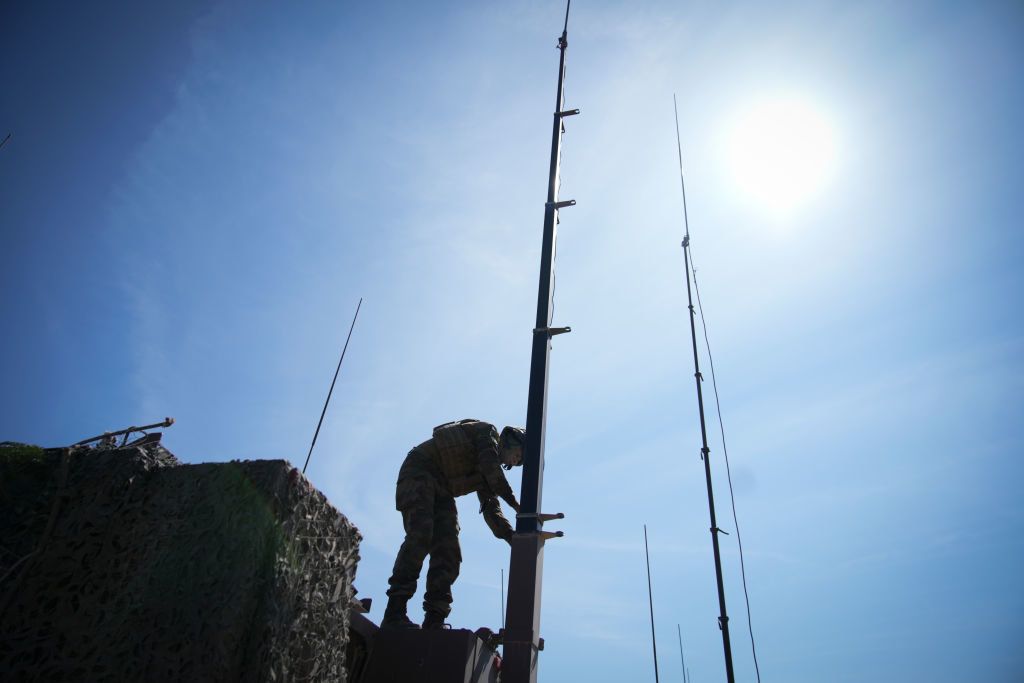Feature
Meshed networks: the future of battlefield comms
The future of battlefield communications could see the integration of AI enabled meshed networks and Low Earth Orbit satellite connectivity. Andrew Salerno-Garthwaite reports.

A soldier is seen holding a communications antenna near Tapa, Estonia on 20 May, 2023 (Photo by Jaap Arriens/NurPhoto via Getty Images)
As detailed in the August issue of Global Defence Technology in conversation with British Army Brigadier Neil Budd, who leads the service’s first Recce-Strike complex, the crux of this blend of leading-edge sensor units and deep battle precision strike effector units rests with high-paced left-right meshed communications between units in the field, without intermediaries at headquarters.
The technological advancement that boosts performance in this regard is the meshed communication network, that routes requests between units by relaying the signals through other units in the mesh to the intended recipient, explained Dr Rajeev Gopal, vice president for Advanced Programmes at satellite and communications company Hughes.
While the use of meshed communications networks added to the speed at which decisions could be made for the allocation of effector units against targets in the recent Warfighter 2023 exercise, Budd described some friction within the communication network stemming from the sheer number of requests being relayed between the units.
Meshed networks under stress
In a battlefield setting where communications are put under stress, perhaps because of obstructing terrain, the meshed network is intended to route messages through alternative means. For communicating across an obstruction, the meshed network looks to any available intermediaries in the field and passes on the request to any and all nodes that are available.
The process of searching for another neighbouring node then begins again and is repeated until the message reaches its destination. By the third or fourth tier of the relay, tens of nodes could be activated for a single message meant to involve only two people.

Credit: akinbostanci via Getty.
Expanded across a whole battalion this adds a considerable burden to coordinating communication, and so the organisation is passed off to software operating along predetermined thresholds. It might limit the number of nodes approached at each step to limit how expansive the communication becomes or select only a number of nodes that have a high level of signal connectivity.
However, in the dynamic setting of a battlefield, traditional software normally employed can be too regimented to respond appropriately. Where disruptions are the result of localised jamming, or a kinetic attack that has removed a communication node in the formation, a human operator would weigh the various risks with a level of intuition that does not rely on hard decisions, operating in a region of possibility rather than looking for a point solution. But again, the level of coordination between a network of human operators would make the latency in the systems too great for successful operations.
LEO satellites bridging gaps
Gopal said that this is something artificial intelligence (AI) does very well. Under such coordination the system can go beyond hard boundaries to contact more nodes if a communication has not been bridged. It can even demonstrate something like human patience, waiting for a response if none has occurred, and then trying again.
“All this used to be handcrafted by engineers, and today, with AI modelling, all the collective wisdom and operational input is inbuilt in these models. So these kinds of decisions, which human beings had to do - and human beings, of course, are very intuitive - that intuition also gets embedded with AI machine learning,” Gopal detailed.
So, these kinds of decisions, which human beings had to do - and human beings, of course, are very intuitive - that intuition also gets embedded with AI machine learning.
Dr Rajeev Gopal, vice president for Advanced Programmes at Hughes.
Where a team needs to communicate with further away sites, meshed networks can be interfaced with Low Earth Orbit (LEO) satellites, allowing connectivity with points anywhere in the world, while allowing local self-contained connectivity within the meshed network for low-latency communication between sensor and actuator units.
Advancement on this technological front in recent years, Gopal pointed out, is a result of the introduction of standards such as Internet Protocol (IP), the 3rd Generation Partnership Project (3GPP) and its fifth generation (5G), making use of these different transports. The standards have led to commercial entities producing dual-use technologies with economies of scale benefits that drive down the cost of introduction.

AI could harness commercial satellites to improve battlefield communications. Credit: Vector illustration Who_I_am via Getty.
The range of transports for communication lead to a future with a “unified connectivity, where we have LEO constellations, geostationary constellations, we have mesh networks, we have 5G enabled tactical, local connectivity - and they're all integrated together,” stated Gopal.
“I think just like computing, in communication, also, the commercial segment is playing a much bigger role compared to 20 years ago, 30 years ago. Commercial participation does not mean that security or assurance is compromised because of the latest advances in resiliency.
“It is perfectly possible to use multiple transports, which may be of commercial grade. But when you orchestrate these transports together, then you get very high assurance and very high availability.”
Rapid Tiger tests multi-transport resiliency
At the recent Rapid Tiger exercise in California this October, Hughes Defense & Government Solutions demonstrated the application of multiple communication transports in commercial satellite technology under stress in command-and-control operations with the Combined Force Space Component Command (CFSCC).
If someone is trying to jam or something breaks down, or there’s a kinetic attack, automatically the system has the full set of resources which are available, and it can decide how to route the traffic using the transports which are still available, while the compromised transport might be reconstituted.
Dr Rajeev Gopal, vice president for Advanced Programmes at Hughes.
The exercise comprised several test scenarios that were based on the capabilities required by the Combined Space Operations Center SATCOM Integrated Operations Division (CSpOC SIOD) to support and maintain satellite communications to defence personnel worldwide despite system disruptions in a crowded and contested environment.
Resilient terminal registration and situational awareness were tested using a local Primary-Alternate-Contingency-Emergency (PACE) plan in a blackout scenario. The intention behind maintaining a PACE plan is to build a level of resilience into the communication system. “If someone is trying to jam or something breaks down, or there’s a kinetic attack, automatically the system has the full set of resources which are available, and it can decide how to route the traffic using the transports which are still available, while the compromised transport might be reconstituted,” said Gopal.
In essence, this was a live communication swap between two commercial satellite communication spacecraft. In the event of a blackout, the Primary (P) GEO connection would fail and transition to a Contingent (C) LEO link; when the equipment on the second route failed, it would then move to an Alternate (A) link. The recorded P to C to A switchover periods were expressed in seconds. Additionally, the opposite path—in which A to C to P was returned to its initial condition and the failed terminals were brought back online—was shown to work effectively.

Caption: The Combined Force Space Component Command Operations Directorate team stands at the first “Rapid Tiger” advanced training event from 28-31 March, 2022. Credit: US Space Force/Lt. Col. Mae-Li Allison
Also during Rapid Tiger, the system was tested against 'brownout' scenarios. This dealt with what would happen if an adversary interfered with signals using electromagnetic warfare in order to prevent communication. On the occasion, the primary link was shown to sense and identify the electronic jamming and quickly switch to the contingency to retain the communications connection.

Caption: The US Pentagon is seeking to reduce carbon emissions through a range of programmes, but will it go far enough? Credit: US DoD
Australia could be one of the main beneficiaries of this dramatic increase in demand, where private companies and local governments alike are eager to expand the country’s nascent rare earths production. In 2021, Australia produced the fourth-most rare earths in the world. It’s total annual production of 19,958 tonnes remains significantly less than the mammoth 152,407 tonnes produced by China, but a dramatic improvement over the 1,995 tonnes produced domestically in 2011.
The dominance of China in the rare earths space has also encouraged other countries, notably the US, to look further afield for rare earth deposits to diversify their supply of the increasingly vital minerals. With the US eager to ringfence rare earth production within its allies as part of the Inflation Reduction Act, including potentially allowing the Department of Defense to invest in Australian rare earths, there could be an unexpected windfall for Australian rare earths producers.
Total annual production

$345m: Lynas Rare Earth's planned investment into Mount Weld.

Phillip Day. Credit: Scotgold Resources